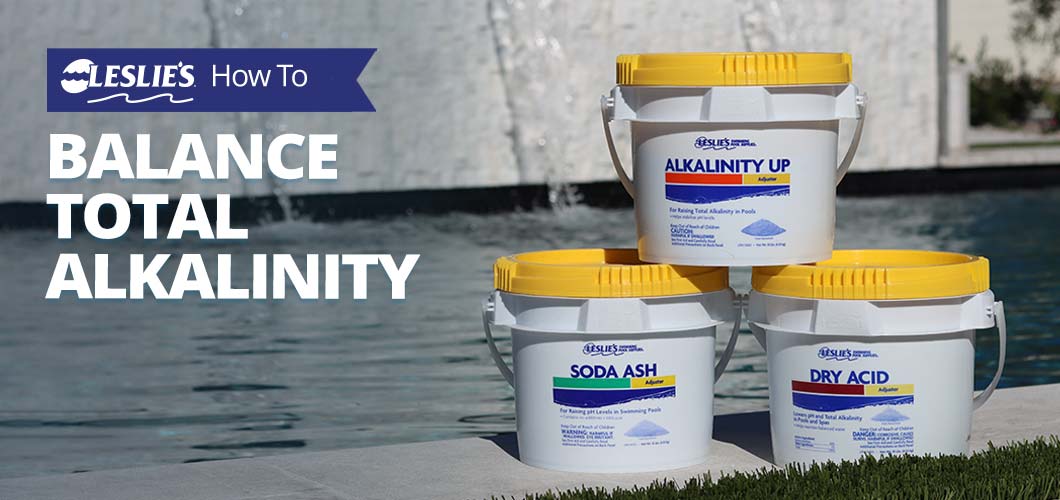
How to Balance Total Alkalinity in a Pool
You've just finished testing the balance of your pool water, and realized your Total Alkalinity levels are out of range. Maybe you noticed there was low alkalinity in the pool, or perhaps the pool alkalinity was too high. Now you're probably asking yourself, why is Total Alkalinity important for a healthy pool? What is it, and how can you get it back in proper balance? Great news — you're in the right place. Keep reading to learn more about Total Alkalinity in your pool.
What is Total Alkalinity?
Total Alkalinity, sometimes abbreviated as TA, is the measurement of alkaline substances in your pool water. It's the counterpart to pH, acting as a buffer to stabilize pH levels. When TA levels are unbalanced, pH can fluctuate much more rapidly, or it can be incredibly difficult to adjust pH within the recommended range.
Why is Total Alkalinity Important?
Keeping both Total Alkalinity and pH balanced is a crucial part of pool maintenance, especially when it comes to sanitizer performance, swimmer comfort, and protecting your pool and equipment. When TA is out of range, pH levels often aren't stable. And when pH isn't stable, it can lead to metal corrosion, pool surface stains, cloudy water, decreased chlorine efficiency, and a generally uncomfortable swimming experience thanks to acidic or alkaline water.
BONUS TIP: Metals in pool water can cause problems with staining when your water is unbalanced. Before you start balancing Total Alkalinity, protect your pool against metal stains with Leslie's NoMetal.
How to Balance Total Alkalinity in a Pool
A good rule of thumb is to keep your Total Alkalinity levels between 80–120 ppm. Keep in mind, however, that the ideal range for TA in your pool varies slightly depending on what kind of sanitizer you use:
| Primary Sanitizer Type | Ideal TA Range |
| Bromine | 100–120 ppm |
| Cal-hypo | 80–100 ppm |
| Dichlor | 100–120 ppm |
| Liquid chlorine | 80–100 ppm |
| Trichlor | 100–120 ppm |
To balance Total Alkalinity, you will need:
- Leslie's Alkalinity Up or Leslie's Soda Ash to increase levels
- Leslie’s Dry Acid or Muriatic Acid to decrease levels
- Water testing kit to check water balance
- Safety goggles
- Acid-resistant gloves
As you'll notice, many of the same chemicals used to adjust Total Alkalinity are also used to adjust pH. When balancing a pool, always correct any TA imbalances first before addressing pH. For more information on how to balance pH, check out our blog.

How to Increase Low Total Alkalinity
You test your pool water and find that the Total Alkalinity level has dropped below 80 ppm. Now what? The chemicals you use will depend on the pH levels.
If your pool’s pH is balanced, use Leslie's Alkalinity Up (sodium bicarbonate). But, if you need to increase both TA and pH, use Leslie's Soda Ash (sodium carbonate). Follow product label instructions carefully for correct dosing and application information.
BONUS TIP: Not sure how big your pool is? Check out our pool volume calculator for a quick, easy reference chart!
How to Decrease High Total Alkalinity

Now that you know how to handle low Total Alkalinity, what do you do if you test your water and the TA is too high? This is where pool acid comes into play. Leslie’s Dry Acid (sodium bisulfate) will lower TA, but it will also lower the pH. This is where things can get a bit tricky.
You may need to go back and forth between reducing the TA and raising the pH before you get a solid balance for both. Always re-test your water before adding more chemicals to it. Again, always read and follow the product label for dosing and application instructions.
Using Muriatic Acid is another method to lower TA. However, it requires more preparation and caution, because Muriatic Acid needs to be diluted with water before being used in your pool. It is not recommended for use on fiberglass, vinyl liner, or painted pools — use Dry Acid if you have one of these pool types.
How to Dilute Muriatic Acid:
- Always follow label instructions for safe handling and application. This often includes wearing Personal Protective Equipment (PPE).
- Fill a clean bucket with 3–4 gallons of water.
- Slowly add the Muriatic Acid to the bucket. The amount depends on the volume of your pool and the required adjustment. Never add more than 16 oz per 10,000 gallons at one time.
- Carefully mix the water and acid solution with a plastic or wooden utensil.
- With the pump running, pour the solution into the deep end of your pool, or away from the skimmer or any fixtures.
We hope this guide has given you a better understanding of how to balance Total Alkalinity in a swimming pool. If you have questions about pool water chemistry, or if you need guidance on how to use specific chemicals, our team of experts can help! Bring a pool water sample to your local Leslie’s to take advantage of our always free in-store AccuBlue® water test and customized treatment plan. We'll help you pinpoint exactly what's going on with your pool water, then walk you through the steps, products, and dosages needed to remedy any issues.